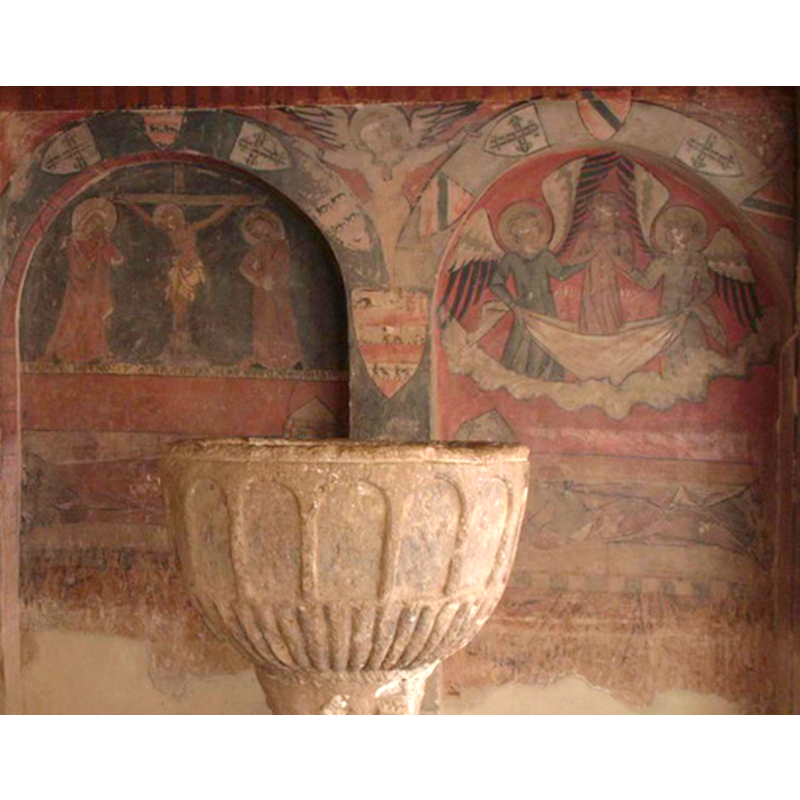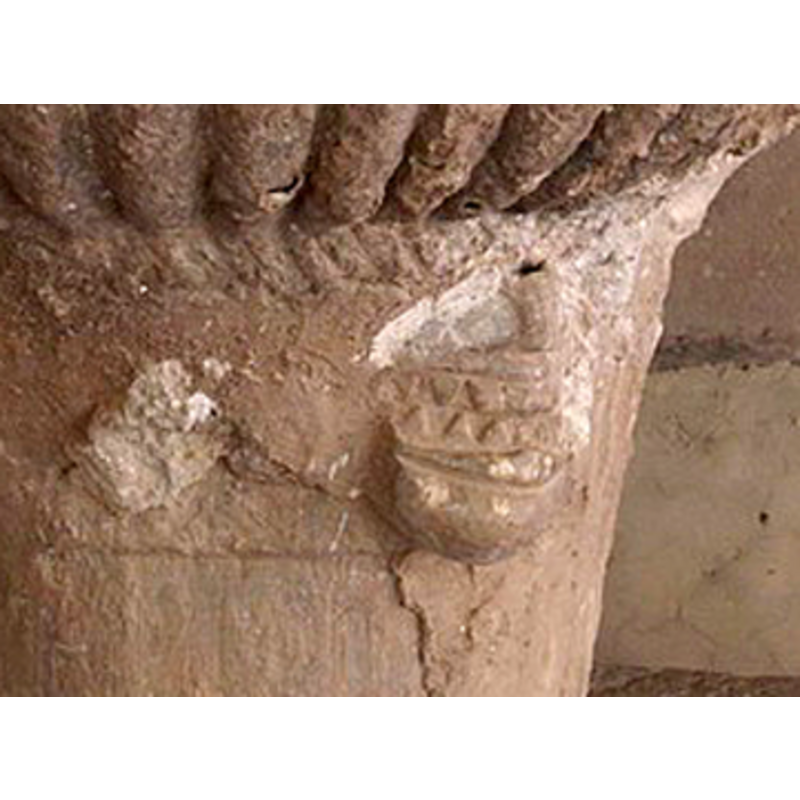Almunia de Dona Godina / La Almunia de Doña Godina / Ermita de Cabañas / Cabanas

Image copyright © Antonio García Omedes, 2006
Image and permission received
Results: 7 records
B01: design element - architectural - arcade - blind - round arches
BU01: design element - patterns - ribbed
LBH01: human figure - head
LBH02: human figure - head
LBH03: human figure - head
view of font
INFORMATION
FontID: 03601ALM
Object Type: Baptismal Font1
Church/Chapel: Ermita de la Virgen de Cabañas
Church Patron Saints: St. Mary the Virgin
Church Location: 50100 La Almunia de Doña Godina, Zaragoza, Spain
Country Name: Spain
Location: Zaragoza, Aragón
Directions to Site: The "Ermita" is located near the town of La Almunia de Doña Godina, itself on the right bank of the river Grío, near its confluence with the river Jalón, 56 km from Zaragoza capital [Coordinates: 41° 29′ 0″ N, 1° 22′ 0″ W 41.483333, -1.366667 -- UTM 30T 636360 4593702]
Font Location in Church: Inside the church, at the W end, beneath the gallery
Century and Period: 13th century (late), Romanesque
Credit and Acknowledgements: We are grateful to Antonio García Omedes, of www.romanicoaragones.com, for his photographs of this font. We are also grateful to José Antonio Cuchí Oterino for his information on the font at the parish church here.
Church Notes: This ermita, which according to the Gran enciclopedia aragonesa (ibid), underwent "una restauración nefasta", has retained some interesting 14th century fresco murals.
Font Notes:
Click to view
Baptismal font described in Abbad (1941) as "tronco cónica" [bucket-shaped] and dated to the end of the 13th century. Illustrated in the Gran enciclopedia aragonesa (1980-1983). Noted in the Encilopedia del románico en Aragón (Zaragoza, 2010). An article by Fernando Arroyo, "El simbolismo bafomético templario y la iconología celtibérica", in the Anales del Instituto Campomanes de Estudios Medievales states that the heads on the base are actually embeded in the stone to which they are held by mortar; Arroyo further informs that these two heads are Celtic, probably removed form an ancient site nearby. The heads are described and illustrated [cf. infra]: 1)head with prominent chin; shows triangular teeth, thick lips, round eyes and a small straight nose; agressive demeanour; it is called "Cabeza de los dientes"; 2)human head with open mouth, a common stance in Celtic representations; it is called "Cabeza de la boca entreabierta". Arroyo refers to the investigations on this object carried out at the Universidad de Zaragoza (Spain) by the archaeologists M. Medrano and M. A. Diaz as source [Medrano, Manuel and Mª Antonia Diaz, Excavaciones Contrebia Belaisca´ 99], whose article 'Cabezas celtas de piedra' is available at www.arxeos.com]. Arroyo mentions that this chapel has been associated with the Knights Templar and their synchretic beliefs. These heads are therefore associated with their worship of Baphometic idols [source: http://usuarios.lycos.es/Larmenius/celtiberos.html]. Illustrated in Cabello Solanas (2002) who raises the alarm on the abandoned treasures of this church: the Romanesque font and the Gothic mural paintings. The font consists of a roughly hemispherical basin the sides of which are ornamented with a blind arcade of round arches all around; the lower part of the basin and underbowl are decorated with a ribbed pattern; the stem of the base is round, with what appear to be carved heads at opposite sides of it [cf. supra]. Its is raised on a substantial two-step plinth. [NB: Cuchi and Lapuente, 2017 [PilasbautismalesFINAL.pdf] [accessed 8 June 2017] note an 18th-century font at the parish church of Nuestra Señora de la Asunción, also in La Almunia de Doña Godina: "realizada en 1788 por el cantero Vicente Tabernas"].
COORDINATES
Church Latitude & Longitude Decimal: 41.497979, -1.37485
Church Latitude & Longitude DMS: 41° 29′ 52.72″ N, 1° 22′ 29.46″ W
UTM: 30T 635646 4595315
MEDIUM AND MEASUREMENTS
Material: stone, limestone?
Font Shape: hemispheric (mounted)
Basin Interior Shape: round
Basin Exterior Shape: round
Rim Thickness: 11 cm*
Diameter (inside rim): 72 cm [calculated]
Diameter (includes rim): 94 cm*
REFERENCES
Gran enciclopedia aragonesa, Zaragoza: Union Aragonesa del Libro, 1980-1983
Abbad, Francisco, "Pilas bautismales románicas", t. 14, no. 45, Archivo Español de Arte, 1941, pp. 313-315; p. 314
Arroyo, Fernando, "El simbolismo bafomético templario y la iconología celtibérica", 2000, Anales del Instituto Campomanes de Estudios Medievales, 2000
Cabello Solanas, Santiago, Retratos de la memoria II: fotografías antiguas de La Almunia de Doña Godina, Zaragoza: Institución Fernando el Católico, 2002
Fundación Santa María la Real, Enciclopedia del románico en Aragón, Aguilar de Campoo: Fundación Santa María la Real, Centro de Estudios del Románico, 2010



